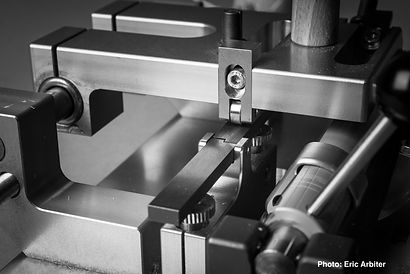A Clarification About Non-parallel Profiler Carriages
- ericarbiter
- Mar 27, 2024
- 3 min read
Recently I got an email from a reader of my blog on the Way of Cane Machine Service site concerning my article, Two Factors That Compromise Bassoon Profilers:
In that posting I showed a diagram of what happens when we adjust our profilers while the blade is still dull and bowed inwardly from wear by changing the shims or settings to compensate. The reader— a very able machine geek— tore down his machine to get the carriage parallel but got his whole machine completely out of whack. Luckily he was able to return it to its original settings right away and get then everything squared away after emailing with me.
I'll post the diagram here again:

I went back and re-read my comments about this point and although I was fairly clear about why resetting the machine will probably cause the tip corners to be of different thickness, I’d still like to clarify a few points: mainly NOT to change the settings until dealing with the blade. If you already have, then you will probably end up with the differences of tip thicknesses in the corners.
So this difference in thickness is a symptom. What I’d like to stress is that the real problem is the blade’s wear, so if there’s anything important I’d like to say and stress it’s to advise bassoonists to first and foremost deal with the blade’s wear and sharpness BEFORE doing any changing of your profiler’s settings. My diagram and all my writing about the parallel carriage was just to explain what happens once bassoonists try and compensate for the blade wear by resetting their machines.
In summary, the steps ideally should be:
1) Once you notice your profile getting heavier and it feels like a lot more work to profile the cane, sharpen or get a new blade if your machine is still in production and new blades are available or your machine's maker can sharpen them.
2) Make sure the new blade is set in the carriage according to the manufacturer’s design. Let me unpack this a bit. Rieger and Reeds ‘n Stuff have gauges to set their blades in the carriage correctly. You don’t need these gauges to set your machines but they give you the projection values inscribed on the gauge and this is very useful. I give these below. As I mention in several blogs, this is part of the design of each machine. The sharp blade set to the engineered projection of the blade sets up the whole geometry of the cut so that the carriage can be as close to parallel as possible at the tip. Most of the German machines that I work on and study have a very small projection past the carriage’s cane hold-down bar, generally between .04-.05mm or .0015- .0019” around 2 thousandths of an inch. Recall that a typical human hair measures around three thousandths of an inch — .003”. This setting cuts a very thin ribbon of cane with each pass. So setting the projection to yield a strip of cane around .004” (.101mm) will work fine. At this ribbon thickness of cane it takes many passes to completely profile a piece of cane.
In contrast to these machines, the old Pfeifer machines (at least mine as set by Freddy Pfeifer when it was delivered to me in 1975) the blade projected around .015” – fifteen thousandths or an inch or .38mm. Having said this some Pfeifer machines were set at different projections past the hold-down bar, especially the Pfeifer double profilers. At this setting the Pfeifer machines profile a piece of cane with far fewer passes than the German machines. My point is that each machine may have differently designed set ups and geometry.
I cover this in some depth in this posting:
This is the starting point of setting up bassoon profilers and it’s a juggling act to first get the blade restored, then sett the projection, “correctly” and finally checking the profile and making sure the corners of the tip are near the same thickness. It’s sometimes necessary to reset to get the carriage to parallel but in my experience that’s only a last resort.
The rule of thumb (appropriate for bassoonists!!) is: leave the settings alone until the blade is sharp and the projection is properly set.
I hope this helps to clarify my thoughts and procedures for servicing your machines and also to prevent bassoonists from unnecessarily changing their adjustments if they have worked well in the past.
My next posting will cover how to go about sharpening blades for those of you who might want to do it yourselves.





Comments